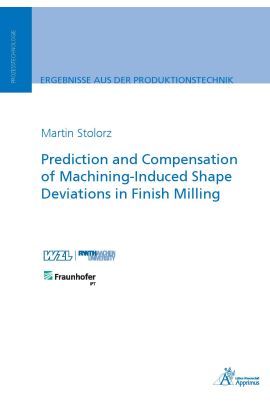Hard finish milling is a key manufacturing technology for manufacturing tools, dies and moulds made of difficult to machine materials. Those parts request high geometrical precision which in turn leads to an expensive and time consuming manufacturing process. The problem is that in multi-axis hard finish milling the relative motion of the applied ball-end milling tool is always accompanied with systematic deviations in respect to the forecasted relative motion calculated in CAM. From this point, process designers are motivated to avoid dimensional inaccuracies in milling by predicting and compensating machining-induced geometrical shape errors during the process design phase.
In this work a method is developed to predict and compensate the machining-induced deflection of the ball-end milling tool mainly by calculating the permanently changing engagement conditions between the workpiece surface and the applied milling tool geometry. For this purpose a method is developed for reconstructing surface normal vectors of free-form workpiece surfaces for each NC tool path point while using solely a given set of two varying NC tool path configurations and a known process parameter set. This approach does not necessitate 3D CAD models of workpiece geometries or initial CAM files, which is an advantage over traditional reverse engineering approaches.
Based on the method for reconstructing the normal vectors of free-form shaped workpiece geometries, sub-models are developed to calculate explicitly for each NC tool path point:
- the local inclination angle between workpiece and milling tool,
- the local workpiece surface curvature,
- the thickness of the local uncut chip.
Those sub-models base solely on vector analysis expressions. This makes the approach mathematically more stable considered to numerical approaches.
Based on a the analytical model for calculating the local engagement conditions and a developed tool wear-related model, a method was developed to map local wear values to the radial cross-section of the circular shaped ball-end milling tool. Finally, an analytical-empiric tool deflection model is implemented into the addressed approach for developing an integrated approach to spatially transform the position of each NC tool path point individually towards the negative direction of the local surface normal vector.
| Autor | Stolorz, Martin |
|---|---|
| Lieferzeit | 3-4 Tage |
| Gewicht | 0.246 kg |
| Erscheinungsdatum | 12.09.2017 |
Prozesstechnologie
Prediction and Compensation of Machining-Induced Shape Deviations in Finish Milling
Kurzbeschreibung
In this work a method is developed to predict and compensate the machining-induced deflection of the ball-end milling tool by calculating the engagement conditions between the workpiece and the milling tool for each single NC tool path point. Sub-models for calculating the deflection and wear of the milling tool are integrated into to method to spatially transform the position of each NC tool path point individually towards the negative direction of the local surface normal vector.

